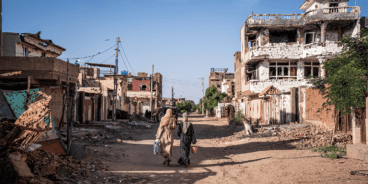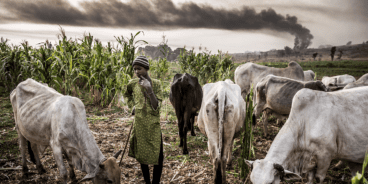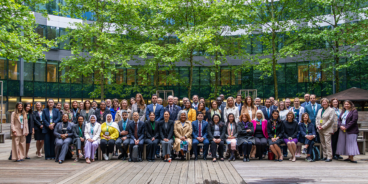
Presentation to the UN Security Council Working Group on Conflict Prevention and Resolution in Africa
Introduction
Thank you, Ambassador Kumalo, for this opportunity to brief the Security Council.
I am here to represent the Global Centre for the Responsibility to Protect – created in February this year to catalyze action to move the 2005 agreement on the responsibility to protect populations from genocide, ethnic cleansing, war crimes and crimes against humanity from principle into practice.
Overview of Presentation
We have been asked to offer our views for discussion, prompted by the South African concept paper prepared for this meeting.
In the view of the Global Centre, there are two important themes to the paper:
-
-
- That R2P is about prevention, and should not be viewed as synonymous with military intervention;
- A desire to find non-violent solutions to pre-violent situations.
-
In this presentation, I am going to argue that if member states want to be serious about the early prevention of mass atrocity crimes – and to achieve non-violent solutions to pre-violent situations – it requires a step change in how member states behave.
This includes action at the national level and bilateral action that does not necessarily involve the Security Council.
But, considering the specific role of the Council: If the Council wants to be serious about fulfilling its responsibility to protect populations from genocide, ethnic cleansing, war crimes and crimes against humanity, it too is going to have to demonstrate a step change in how it engages with situations where people are at risk – in its receptivity to information, its willingness to put such situations on its agenda, and in its willingness to take early action, appropriate to the situation at hand.
Failing to do this will leave the Council faced with the necessity of taking more intrusive, coercive measures, or simply failing to fulfill its responsibilities, with the consequence of massive human suffering, as is the case in Zimbabwe, Darfur and Eastern DRC.
I will explore each of these challenges in turn.
What governments need to do to prevent mass atrocity crimes
To reiterate briefly, fulfilling the responsibility to protect populations from mass atrocity crimes is NOT all about the Security Council.
For governments to be serious about preventing mass atrocity crimes requires commitment at the national level, and bilaterally, with the provision of meaningful capacity building and technical assistance, potential political intervention to mediate and resolve disputes, and corresponding willingness of recipient states to accept help.
This does not necessarily require action by the Security Council, though each of the Council’s members has responsibilities in this regard in their national capacity and through their membership in regional institutions.
The role of the Security Council
Yet, if one considers the particular role of the Security Council, the implication of paragraph 139 of the World Summit Outcome Document is that the Security Council has a role to in helping protecting populations from mass atrocity crimes in line with Chapters VI and VIII of the UN Charter, and, where there is manifest failure by the state, with Chapter VII measures.
If the Council wants to be part of meaningful efforts to prevent mass atrocity crimes – achieving non-violent solutions to pre-violent situations – it will have to change its past practice in a number of ways.
Greater receptiveness to early warning information.
The possibility of early preventive action by the Council will depend on the Council being alert and receptive to information where populations are at risk of mass atrocity crimes.
There are multiple sources of information available to the Council.
The SG has crucial role to alert the Council. He has the Special Adviser on the Prevention of Genocide, the High Commissioner for Human Rights, the Emergency Relief Coordinator, and Under-Secretaries-General for Political Affairs and Peacekeeping to advise him and to brief the Council.
Arria Formula briefings allow NGOs on the ground to report directly to the Council.
Article 34 of the Charter provides the Council with chance to launch investigations into situations of potential concern.
The Council could also ensure it has working methods which allow discreet briefings from DPA or regional mediators involved in tackling emerging crises; or dispatch a small delegation of members to gain further understanding of a particular situation.
In short, there are many sources of information about populations at risk. The Council needs to be more open to them.
The Council needs to show greater willingness to accept country situations onto its agenda in way that it has not in the past.
In practice, members of the Security Council, time and again, deflect Council attention from situations where there is a risk of mass atrocity crimes by arguing somehow that such situations are not within the purview of the Council.
Burma, Uganda, Darfur, Zimbabwe: Council members have resisted consideration of all these situations.
Most recently, the representative of the Russian Federation, in his 12 July explanation of vote against the draft resolution to impose sanctions on Robert Mugabe of Zimbabwe, castigated attempts to ‘take the Council beyond its prerogatives of maintaining international peace and security.’
Yet the implication of paragraph 139 of the World Summit Outcome Document is that Council should be ready to accept a situation onto its agenda where it can help protect populations from mass atrocity crimes.
If the Council is going to deliver on aspirations to support early action to protect populations at risk, it is going to have to accept such situations onto its agenda.
The Council needs to demonstrate its willingness to respond quickly to early warning signs of mass atrocity crimes before widespread death and suffering takes place.
This is the crux of it: whether or not the Council is willing to take early action to preclude the need for more intrusive, coercive measures later on.
The reality appears to be the Council can never bring itself to act before a situation becomes catastrophic.
Darfur is a painful and powerful case in point.
By the autumn, or fall, of 2003, hundreds of thousands of villagers in Darfur were fleeing attacks orchestrated by the Government of Sudan.
On 29 November, the UN Humanitarian Coordinator stated that 607,000 Darfuri people had become displaced by such attacks.
At the same time, the government of Sudan prevented humanitarian organizations from reaching the affected populations. A similar pattern of atrocities perpetrated earlier against citizens in the south of Sudan strongly implied a government policy of ethnic cleansing.
At this time – November 2003:
-
-
- The UN Security Council could have asked for a briefing on Darfur, and issued a Presidential statement condemning the action and calling for it to stop, stating its willingness to take further measures if this did not occur.
- The African Union or the Organization of the Islamic Conference could have offered – or been asked – to mediate the dispute between the government and the rebels.
- The Secretary-General could have dispatched a high-level envoy to support or lead mediation efforts.
- Mediators working on the North-South settlement could have insisted on expanding the talks to include Darfur.
-
This didn’t happen and the situation in Darfur today is a direct consequence of the Council’s failure to take more timely action to protect hundreds of thousands of people at risk of mass atrocity crimes.
To prevent mass atrocity crimes, the Council will have to ensure it uses the means at its disposal in timely and innovative ways.
Just looking at the ‘non-violent’ means, high-level mediation is clearly a crucial tool. The Kenya case was an example, par excellence, of swift decision about the need for effective high level mediation to prevent mass atrocity crimes.
The Council can support the efforts of regional organizations, such as the OAU-led peace negotiations in Burundi in 1996.
But this may not be enough.
Effective prevention does not just mean using talk as opposed to force. It often means using force -ideally, in a consensual manner.
The deployment in September 1999 of an Australian-led multinational force to Timor-Leste to quell widespread violence and rampaging by militias came with the consent of the Indonesian government. Over a matter of weeks, roughly 2500 soldiers supervised the peaceful withdrawal of Indonesian soldiers. By February 2000, the multi-national force had handed over to a fully fledged UN mission.
The 2003 deployment of 1400 European troops to eastern DRC in Operation Artemis is another reminder that short-term preventive deployment has saved lives in the past and must be seriously implemented now in eastern Congo.
The Council needs to reflect on how it has used the measures it has, where else it has been successful and identify additional innovations in how it responds.
The Global Centre for R2P wants to help on this through its program of research. But making sure the measures are right depends on assessment of the nature of the threat. There is a fifth challenge for the Council.
The Council must demonstrate the ability to distinguish between those situations where the threat to populations arises from the state as the perpetrator of mass atrocity crimes, as opposed to those where the state lacks capacity to protect its population.
One of the most powerful lessons of Rwanda’s genocide was the need to respond robustly to a state that was a perpetrator of mass atrocity crimes against its population.
Such response may fall short of military intervention.
Taken early enough, sufficient consistent pressure, coordinated with regional institutions, including targeted financial and travel sanctions, robust diplomatic sanctions removing leaders from positions of authority in international institutions, enforced arms embargoes, the threat or actual referral to the ICC , tackling sources of finance through measures on the illicit exploitation of natural resources…all these measures could contribute to changing the course of governments with ill-intent towards their populations.
Yet the clear implication of the Rwanda case: where a state is set on attacking its people, Council will have to consider a coercive protective presence to save people’s lives and halt the commission of mass atrocity crimes.
Conclusion
To date, the Security Council has rarely demonstrated an ability to reach a ‘broad consensus’ referred to in the South African paper on its need to act to prevent mass atrocity crimes before a situation becomes catastrophic.
Being serious about preventing the mass atrocity crimes stipulated in the 2005 agreement on R2P requires real change in the Council’s behavior.
It cannot continue to adopt a wait and see approach and then fail to act when the bodies of the dead pile up and become pictures on the TV screens.
In the absence of changes in how the Council engages in situations where populations are at risk, we can only assume that the future will follow the track of the past.
Unless and until there is a change from UN member states and the Security Council in each playing their role to prevent mass atrocity crimes, the UN has to be planning, developing capacity and doctrine, and calling for the Security Council to demonstrate the political will required to respond forcefully when it becomes clear that early prevention has failed.
The current situation in Darfur, Zimbabwe, and eastern DRC prove that this continues to be the case.
Thank you.
Related Content


Atrocity Alert No. 444: Nigeria, Haiti and South Sudan
